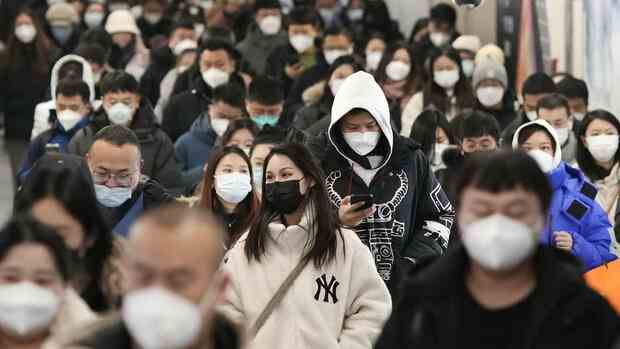The birth rate was last given as 6.77 newborns per 1000 people.
(Photo: dpa)
Beijing China’s population shrank last year for the first time in six decades. At the end of December, the most populous country in the world had 1.411 billion inhabitants, around 850,000 fewer than a year earlier, the statistics office in Beijing said on Tuesday.
Experts speak of a “turning point” in China’s history and warn of the devastating consequences of an “unimaginable” population crisis. “China’s demographic and economic prospects are bleaker than expected,” says US social scientist Yi Fuxian of the University of Wisconsin. “China will have to go through a contraction.”
It must also change its social and economic policies. The surplus of working people, which had boosted China’s economic miracle as the “workbench of the world”, is now being followed by a labor shortage: “China’s manufacturing sector is becoming understaffed and aging – and declining as quickly as Japan’s,” says Yi Fuxian.
It was the first population decline since 1960 and 1961, the statistics office reported, without commenting on the numbers separately. At that time, tens of millions of people had died in the devastating famines as a result of Mao Tsetung’s misguided industrialization campaign of the “Great Leap Forward”.
Top jobs of the day
Find the best jobs now and
be notified by email.
The birth rate last year was only 6.77 newborns per 1000 people – a historic low. For the first time in the history of the People’s Republic, the number of births was below 10 million.
Just 9.56 million babies were born while 10.41 million people died, the Statistics Bureau reported. The death rate was 7.37 per 1000 people. This results in a population growth of minus 0.6 to 1000 people.
The end of the one-child policy could not stop the trend
The independent researcher Yi Fuxian, who has been following the Chinese population development critically for a long time, still considers the current figures to be embellished. According to his calculations, the Chinese population has been shrinking for four years.
At least he sees an official acknowledgment that the decline came about ten years earlier than previously predicted by the government. Unlike the famines of 1960 and 1961, however, the trend is now “irreversible,” says Yi Fuxian.
Birth rates have been falling steadily for years, while society is aging. The effects of the “one child policy” that has been in place since 1979 are becoming more and more noticeable.
The abolition of controversial birth control in 2016 led to a slight increase in births only for a short time. Having only one child is the social norm in China today. Two generations have never experienced it any differently, so it’s deeply rooted in society.
In addition, experts see the high costs of housing, education and health care in China and the dwindling willingness to marry as the main reasons for the worrying development. The corona pandemic, which has been going on for three years, and high unemployment, especially among young people, created further uncertainties that are likely to have accelerated the trend. Almost every fifth young person between the ages of 16 and 24 is unemployed in China’s cities.
In response to the declining birth rate and the rapid aging of the population, three children were also allowed in 2021. Since then, the government has also been trying to make it easier for young couples to care for children.
The costs of kindergartens and schooling have been reduced. Financial aid was granted, maternity and parental leave were made easier. Because many women fear that motherhood will have a negative impact on their professional career.
The consequences of the population crisis for the second largest economy are enormous. Fewer and fewer working people have had to take care of more and more old people for a long time. Today every fifth Chinese is older than 60 years.
If in 2020 five employees between the ages of 20 and 64 supported an older person over 65, in 2050 there will only be 1.5 employees. “Without a social safety net, without family security, a pension crisis will develop into a humanitarian catastrophe,” warns researcher Yi Fuxian.
More: The ten countries with the most inhabitants
